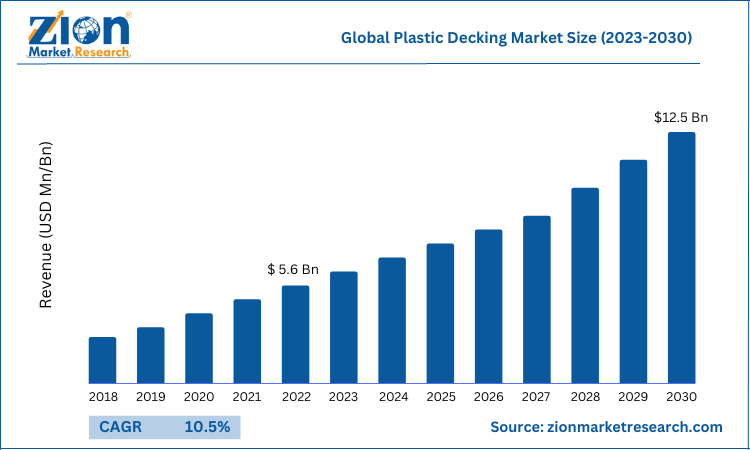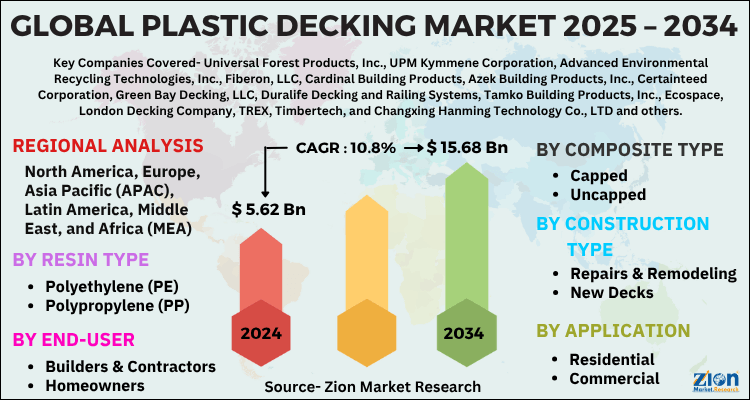Plastic Decking Market Size, Industry Analysis, Share, Forecast 2034

Plastic Decking Market By Resin Type (Polyethylene (PE), Polypropylene (PP), HDPE, LDPE, Polyvinyl Chloride (PVC), and Others), By Composite Type (Capped and Uncapped), By Construction Type (Repairs & Remodeling and New Decks), By Application (Residential, Commercial, and Industrial), By End-user (Builders & Contractors, Homeowners, and Construction Companies), and By Region: Global and Regional Industry Overview, Market Intelligence, Comprehensive Analysis, Historical Data, and Forecasts 2025 - 2034
| Market Size in 2024 | Market Forecast in 2034 | CAGR (in %) | Base Year |
|---|---|---|---|
| USD 5.62 Billion | USD 15.68 Billion | 10.8% | 2024 |
Plastic Decking Market: Industry Perspective
The global plastic decking market size was worth around USD 5.62 billion in 2024 and is predicted to grow to around USD 15.68 billion by 2034 with a compound annual growth rate (CAGR) of roughly 10.8% between 2025 and 2034. The report analyzes the global plastic decking market's drivers, restraints/challenges, and the effect they have on the demand during the projection period. In addition, the report explores emerging opportunities in the plastic decking industry.
Plastic Decking Market: Overview
Plastic decking is a flat surface that is typically used higher than the ground level in front facades of buildings. It is mainly made of recycled plastic or virgin plastic, which is made without the use of fillers during the manufacturing process. Plastic decking is extremely stain-resistant and does not require finishing or significant maintenance. It keeps the visual value and deck quality intact because splintering is not a problem. Additionally, plastic decking exhibits excellent resistance to fading and moisture. As a result, it can be used in areas with high humidity and frequent rain. Plastic decking has been encouraged for use in the building of residential decking boards, window lines, rails and balusters, door components, sliding, and fencing due to its extensive durability.
Key Insights
- As per the analysis shared by our research analyst, the global plastic decking market is estimated to grow annually at a CAGR of around 10.8% over the forecast period (2025-2034).
- Regarding revenue, the global plastic decking market size was valued at around USD 5.62 Billion in 2024 and is projected to reach USD 15.68 Billion by 2034.
- The plastic decking market is projected to grow at a significant rate due to rising demand for durable, low-maintenance outdoor flooring solutions, especially in residential and commercial construction.
- Based on the resin type, the Polyvinyl Chloride (PVC) segment is expected to dominate the market during the forecast period.
- Based on the composite type, the capped segment accounted for the largest market share in 2022 and is expected to continue the same pattern during the forecast period.
- Based on the construction type, the new deck segment is growing at a rapid rate over the forecast period.
- Based on the application, the residential segment is expected to dominate the market over the forecast period.
- Based on region, North America is expected to dominate the market during the forecast period.
Plastic Decking Market: Growth Drivers
Increased demand for plastic decks because of their benefits drives the market growth
Major factors influencing the global plastic decking market revenue growth include rising urbanization and industrialization, increased demand for contemporary architecture, and a shift away from the use of conventional materials for decking. Building facades made of recycled plastic materials use plastic decking, an elevated, smooth surface structure. It improves the aesthetic value and quality of a deck while requiring little maintenance and being highly resistant.
These materials are also moisture and humidity-resistant, which boosts their demand in the building sector. Because they are made of synthetic materials rather than natural ones like wood, plastic deck boards are waterproof and weatherproof. Extreme weather conditions like rain, snow, and sweltering heat are no challenge for plastic deck boards. High-Density Polyethylene (HDPE), Low-Density Polyethylene (LDPE), Polyvinyl Chloride (PVC), and polypropylene are the most common materials used to make flooring. Due to their exceptional durability in residential applications, increased use of HDPE and LDPE materials is a key driver fueling market revenue development. Due to its exceptional flexibility and elasticity, recycled plastic is also perfect for creating decking and outdoor furniture.
Plastic Decking Market: Restraints
Ultraviolet rays can damage PVC, which hinders the market growth
Polyvinyl Chloride (PVC) platforms are susceptible to damage from the sun's UV rays. Due to weather and storms, composite flooring gets scratched over time. Products made of PVC for flooring are vulnerable to mold growth, peeling, stains, and deterioration. Homeowners who purchased PVC decking at a premium price often complain that within a year or two, the decking has begun to deteriorate, peel, fade, or develop mildew. This is a consistent pattern in customer complaints. Although consumers frequently encounter resistance from manufacturers when they request replacement decking as per their warranties, the repair of any defective PVC decking products is assured under the warranties. Plastic decking suffers from loose joints and hue changes in hot weather, which restricts the plastic decking industry.
Plastic Decking Market: Opportunities
Technological advancement provides a lucrative opportunity
The plastic decking market players operating in the market are continuously launching innovative products with new features. For instance, in October 2022, the launch of Fire Retardant (FR) Class A decking and siding materials for commercial and residential use was confirmed by Woodbrid LLC. The recently created formula has been put through rigorous testing by ASTM E84-21a, a standard test method for surface burning characteristics of building materials, and a stringent building fire code.
This kind of FR material gives the Woodbrid product line a competitive edge to meet all construction requirements for decking and siding materials. Thus, this type of technological advancement is expected to offer an attractive opportunity for market growth over the forecast period.
Plastic Decking Market: Challenges
The high cost of PVC decking poses a major challenge
PVC decking frequently costs more than comparable, less expensive composites of the same grade. Most makers advise against using PVC with rubber or PVC products (such as a welcome mat) because it has been known to degrade them. This poses a major challenge for market expansion.
Plastic Decking Market: Segmentation
The global plastic decking market is segmented based on resin type, composite type, construction type, application, end-user, and region.
Based on the resin type, the global market is bifurcated into Polyethylene (PE), Polypropylene (PP), HDPE, LDPE, Polyvinyl Chloride (PVC), and Others. The Polyvinyl Chloride (PVC) segment is expected to dominate the market during the forecast period. PVC decking is made of plastic polyvinyl chloride and doesn't contain any organic components like a wood floor. Since PVC doesn't contain any organic material, it is made to avoid some of the drawbacks of organic floorings, such as moisture intrusion that causes mold, mildew, and rot. There is no need to paint, sand, or stain PVC decking. Its rare inclusion of recycled plastic makes it a resource-conserving, green product. The product is significantly lighter than wood composite products and can be twisted and curved to create custom combinations.
Based on the composite type, the global plastic decking industry is segmented into capped and uncapped. The capped segment accounted for the largest market share in 2024 and is expected to continue the same pattern during the forecast period. Wood and recycled plastic are combined to create the inner structure of capped composite decking. Capped composite decking has a recycled content of between 75% and 95%. Besides, the uncapped segment is growing at a moderate rate over the forecast period. Uncapped composite decking outperforms treated wood and is made of a mix of FSC-certified wood and recycled HDPE plastic. It has many advantages and can be purchased from trustworthy suppliers like Composite Prime.
Based on the construction type, the global plastic decking market is segmented into repairs & remodeling and new decks. The new deck segment is growing at a rapid rate over the forecast period. Building facades often use plastic decking, a raised, smooth surface structure made from recycled plastic. It enhances the deck's aesthetic value and quality, is extremely resistant to weather changes and needs little upkeep. Due to their resistance to moisture and humidity, these materials are in higher demand in the building sector.
Based on the application, the global plastic decking industry is divided into residential, commercial, and industrial. The residential segment is expected to dominate the market over the forecast period. The growth in the segment is attributed to customers preferring high-quality and low-maintenance decks. Additionally, the completion of new and existing homes as well as home modifications is fueling the segment's revenue growth. More and more homeowners are focusing on adding a deck to their homes to increase their living space and home value.
Recent Developments:
- In November 2022, at DeckExpo in Las Vegas, Deckorators®, a well-known trademark of UFP Industries, Inc., unveiled its VISTA COMPOSITE DECKING, now with improved traction. With improved traction and slide resistance, Vista Composite Decking will have vertical grain variation. The Vista line, which comes in four colors—Ironwood, Driftwood, Silverwood, and Dunewood—in lengths of 12 feet, 16 feet, and 20 feet with solid- and grooved-edge profiles, offers the greatest degree of design flexibility, including the ability to easily combine two or more colors to create a unique outdoor space.
- In April 2022, the top manufacturer of composite, weather-resistant decking for North American commercial and residential uses, WearDeck®, was acquired by Owens Corning after signing a contract with JR Plastics Corporation. The acquisition of WearDeck is a move forward in the company's strategy to expand Owens Corning further and to reposition their Composites division to concentrate on high-value material solutions for the building and construction industry. WearDeck offers exciting chances to further rely on its expertise in building materials and glass fiber material science technology to substantially broaden the company's current addressable markets.
- In January 2023, the leader in composite decking is expanding the luxury line for 2023 by two new colors, following the successful introduction of Trex Transcend® LineageTM in mid-2022. These new colors add to the company's portfolio of industry-leading decking and offer premium aesthetics, heat-mitigating technology, and better performance supported by a strong 50-year warranty.
Plastic Decking Market: Report Scope
| Report Attributes | Report Details |
|---|---|
| Report Name | Plastic Decking Market |
| Market Size in 2024 | USD 5.62 Billion |
| Market Forecast in 2034 | USD 15.68 Billion |
| Growth Rate | CAGR of 10.8% |
| Number of Pages | 208 |
| Key Companies Covered | Universal Forest Products, Inc., UPM Kymmene Corporation, Advanced Environmental Recycling Technologies, Inc., Fiberon, LLC, Cardinal Building Products, Azek Building Products, Inc., Certainteed Corporation, Green Bay Decking, LLC, Duralife Decking and Railing Systems, Tamko Building Products, Inc., Ecospace, London Decking Company, TREX, Timbertech, and Changxing Hanming Technology Co., LTD and others. |
| Segments Covered | By Resin Type, By Composite Type, By Construction Type, By Application, By End-user, and By Region |
| Regions Covered | North America, Europe, Asia Pacific (APAC), Latin America, The Middle East and Africa (MEA) |
| Base Year | 2024 |
| Historical Year | 2020 to 2023 |
| Forecast Year | 2025 - 2034 |
| Customization Scope | Avail customized purchase options to meet your exact research needs. Request For Customization |
Plastic Decking Market: Regional Analysis
North America is expected to dominate the market during the forecast period
North America is expected to drive the growth of the plastic decking industry during the forecast period. It is anticipated that strong demand for low-maintenance building materials from the region's quickly expanding construction sector will drive market revenue growth. In addition, stringent laws outlawing the use of wood in North America have accelerated the adoption of plastic decking. Consumer interest in outdoor living is anticipated to increase as more people seek to add a deck to their homes to increase their available living space and property value. The primary factors influencing decking demand will be an increase in home renovations and housing completions. As part of the outdoor living trend, more restaurants and hotels are anticipated to construct decks to provide customers with comfortable places to sit and dine outside.
Europe is expected to hold the second-largest market share over the forecast period. One of the most important applications for wood-plastic composites in Europe is decking, where sales of solid profiles outpace those of hollow ones. In November 2021, construction in the nations of the European Union grew by 1.30% compared to the same month the previous year, increasing market demand. Additionally, the French government started making preparations to hold the Olympics in 2024. For instance, the government has authorized a total of about USD 3.3 billion for the development of the Hermitage towers, which are anticipated to be finished by 2024, and in turn, drive the growth of the market during the forecast period.
Plastic Decking Market: Competitive Analysis
The report provides a company market share analysis to give a broader overview of the key market players. In addition, the report also covers key strategic developments of the market, including acquisitions & mergers, new product launches, agreements, partnerships, collaborations & joint ventures, research & development, and regional expansion of major participants involved in the plastic decking market on a global and regional basis.
The global plastic decking market is dominated by players like:
- Universal Forest Products Inc.
- UPM Kymmene Corporation
- Advanced Environmental Recycling Technologies Inc.
- Fiberon LLC.
- Cardinal Building Products
- Azek Building Products Inc.
- Certainteed Corporation
- Green Bay Decking LLC.
- Duralife Decking and Railing Systems
- Tamko Building Products Inc.
- Ecospace
- London Decking Company
- TREX
- Timbertech
- Changxing Hanming Technology Co., Ltd.
The global plastic decking market is segmented as follows;
By Resin Type
- Polyethylene (PE)
- Polypropylene (PP)
- HDPE
- LDPE
- Polyvinyl Chloride (PVC)
- Others
By Composite Type
- Capped
- Uncapped
By Construction Type
- Repairs & Remodeling
- New Decks
By Construction Type
- Repairs & Remodeling
- New Decks
By Application
- Residential
- Commercial
- Industrial
By End-user
- Builders & Contractors
- Homeowners
- Construction Companies
By Region
-
North America
- The U.S.
- Canada
- Europe
- France
- The UK
- Spain
- Germany
- Italy
- Rest of Europe
- Asia Pacific
- China
- Japan
- India
- South Korea
- Southeast Asia
- Rest of Asia Pacific
- Latin America
- Brazil
- Mexico
- Rest of Latin America
- Middle East & Africa
- GCC
- South Africa
- Rest of Middle East & Africa
Table Of Content
Methodology
FrequentlyAsked Questions
Plastic decking also referred to as polyvinyl chloride (PVC) or synthetic decking, is mainly created using recycled or new plastics without the addition of fillers.
The global plastic decking market is expected to grow due to rising demand for durable, low-maintenance outdoor flooring solutions, especially in residential and commercial construction.
According to a study, the global plastic decking market size was worth around USD 5.62 Billion in 2024 and is expected to reach USD 15.68 Billion by 2034.
The global plastic decking market is expected to grow at a CAGR of 10.8% during the forecast period.
North America is expected to dominate the plastic decking market over the forecast period. It is currently the world’s highest revenue-generating market, owing to strong demand for low-maintenance building materials from the region's quickly expanding construction sector will drive market revenue growth.
Leading players in the global plastic decking market include Universal Forest Products, Inc., UPM Kymmene Corporation, Advanced Environmental Recycling Technologies, Inc., Fiberon, LLC, Cardinal Building Products, Azek Building Products, Inc., Certainteed Corporation, Green Bay Decking, LLC, Duralife Decking and Railing Systems, Tamko Building Products, Inc., Ecospace, London Decking Company, TREX, Timbertech, and Changxing Hanming Technology Co., LTD among others., among others.
The report explores crucial aspects of the plastic decking market, including a detailed discussion of existing growth factors and restraints, while also examining future growth opportunities and challenges that impact the market.
HappyClients
Zion Market Research
Tel: +1 (302) 444-0166
USA/Canada Toll Free No.+1 (855) 465-4651
3rd Floor,
Mrunal Paradise, Opp Maharaja Hotel,
Pimple Gurav, Pune 411061,
Maharashtra, India
Phone No +91 7768 006 007, +91 7768 006 008
US OFFICE NO +1 (302) 444-0166
US/CAN TOLL FREE +1 (855) 465-4651
Email: sales@zionmarketresearch.com
We have secured system to process your transaction.
Our support available to help you 24 hours a day, five days a week.
Monday - Friday: 9AM - 6PM
Saturday - Sunday: Closed






